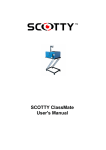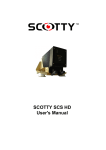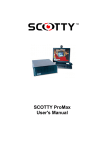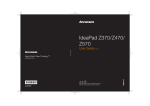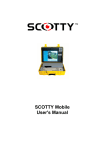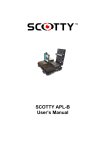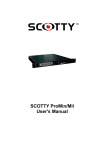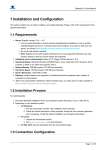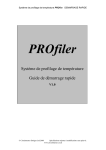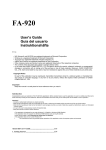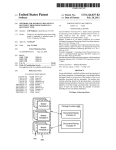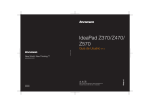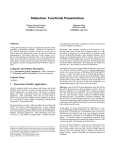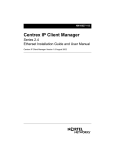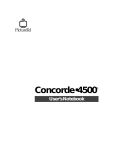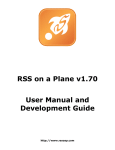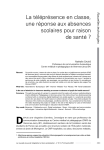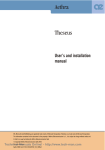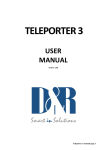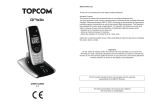Download SCOTTY_Z470_manual_en_A4_V2_14_02
Transcript
Z470 Upgrade Kit User's Manual Copyright 2010 SCOTTY Group plc. All rights reserved. SCOTTY Group plc. (SCOTTY) retains copyright in this manual and associated user documentation (the Documentation). SCOTTY and its suppliers retain all copyright and other intellectual property rights in the software embedded in and associated with the product described in the documentation (the Software). Some products include unmodified software distributed under GNU General Public License (GPL); please contact SCOTTY for further information and source code. No liability for consequential damages. All rights reserved. By purchasing the product described in the documentation you are granted a limited licence to use the Software, provided you do not copy, alter or adapt the Software in any way including decompiling, disassembling or reverse-engineering. The information provided in the Documentation is believed to be accurate and reliable, however, SCOTTY assumes no responsibility for its use, and reserves the right to revise the documentation without notice. SCOTTY, the SCOTTY logo, MobileTM, ProMaxTM, Z470TM, TeleporterTM, and BeamerTM are Trademarks of SCOTTY Group plc. Microsoft and Windows are registered Trademarks of Microsoft Corporation. Version 2.14.02 SD202389A Table of Contents Table of Contents 1 Welcome.............................................................................................1 1.1 Welcome..............................................................................................................1 1.2 Customer Support................................................................................................2 2 Setting Up the System.......................................................................3 2.1 Setting Up the System .........................................................................................3 2.2 Hardware Installation ..........................................................................................3 2.3 Software Installation ...........................................................................................4 2.3.1 Installation from CD ...................................................................................4 2.3.2 Software Update..........................................................................................5 2.3.3 Installation from Installation Package.........................................................5 2.3.4 Software Repair...........................................................................................6 2.3.5 Uninstall ......................................................................................................6 2.4 Connecting Audio and Video..............................................................................7 2.4.1 Video Camera .............................................................................................7 2.4.2 Video Output...............................................................................................8 2.4.3 Microphone .................................................................................................8 2.4.4 Loudspeaker ................................................................................................9 2.4.5 Headset......................................................................................................10 2.4.6 Auxiliary Equipment.................................................................................10 2.5 Connecting to the Network ...............................................................................11 2.5.1 LAN/WAN Connection ............................................................................11 2.5.2 ISDN Connection ......................................................................................11 2.6 System Configuration........................................................................................13 2.6.1 The Setup - Tab.........................................................................................13 2.6.2 The Equipment - Tab ................................................................................14 2.6.3 LAN Configuration – Tab.........................................................................15 2.6.4 The Shortcuts – Tab ..................................................................................18 2.6.5 The "Remote Control" – Tab ....................................................................18 2.6.6 The ISDN Interface - Tab .........................................................................19 3 First Steps ........................................................................................21 3.1 First Steps..........................................................................................................21 3.2 Starting the SCOTTY Teleporter......................................................................21 3.3 The Main Window ............................................................................................21 3.4 Making a Video Call .........................................................................................22 3.5 Checking or Editing a Phone Book Entry .........................................................22 3.6 Creating a New Phone Book Entry ...................................................................22 3.7 Receiving a Call ................................................................................................23 3.8 Terminating a Call.............................................................................................23 SCOTTY Z470 Upgrade Kit User's Manual i Table of Contents 3.9 Transfer of Files with Automatic Hang Up...................................................... 23 3.10 Transfer of Files during a Video Call............................................................. 24 3.11 Opening a Data Conference............................................................................ 24 3.12 Making a Still of the Video ............................................................................ 25 3.13 Controlling the Local Camera ........................................................................ 25 3.14 Controlling the Far End Camera..................................................................... 25 4 SCOTTY Details ...............................................................................27 4.1 SCOTTY Details .............................................................................................. 27 4.2 The Main Window............................................................................................ 28 4.2.1 The Standard Toolbar............................................................................... 28 4.2.2 Camera Control, Controlling the Camera................................................. 29 4.2.3 Audio, Controlling the Audio System ...................................................... 30 4.3 The File Menu .................................................................................................. 31 4.3.1 Dial, Making a Call .................................................................................. 31 4.3.2 Creating or Modifying a Telephone Book Entry...................................... 33 4.3.3 Format for Entering the Telephone Number ............................................ 34 4.3.4 Disconnect, Terminating a Call................................................................ 35 4.3.5 File Transfer, Transfer Files Efficiently................................................... 35 4.3.6 Share, Starting the Data Package.............................................................. 36 4.3.7 T.120 Netmeeting ..................................................................................... 37 4.3.8 H.239 Dual Video Stream ........................................................................ 38 4.3.9 Snapshot, Taking a Still Picture ............................................................... 39 4.3.10 Far End Cam Ctrl, Controlling a Far End Camera ................................. 39 4.3.11 Exit, Ending the Program ....................................................................... 39 4.4 The View Menu................................................................................................ 40 4.4.1 Video Window, Manipulating the Video Window .................................. 40 4.4.2 Camera Control, Activating the Camera Toolbar..................................... 41 4.4.3 Tone Pad, Playing DTMF Tones.............................................................. 41 4.4.4 Local Camera Control, Controlling the Local Camera ............................ 41 4.4.5 Far End Camera Control, Controlling the Far End Camera ..................... 43 4.4.6 Audio & Video Controls .......................................................................... 45 4.4.7 Video Switch Matrix ................................................................................ 46 4.4.8 Pic In Pic, Setting the Picture in Picture view.......................................... 47 4.4.9 Toolbars, Manipulating the Toolbars ....................................................... 47 4.4.10 Received Files, Listing the Received Files ............................................ 47 4.4.11 Connection Info, Displaying the Connection Status .............................. 48 4.5 The Options Menu ............................................................................................ 50 4.5.1 Dialing, Setting the Dialing Parameters ................................................... 50 4.5.2 Audio, Setting the Audio Levels .............................................................. 52 4.5.3 Video, Setting the Video Parameters ....................................................... 53 4.5.4 Data, Adjusting the Data Channel Parameters ......................................... 54 4.5.5 Directories, Setting the SCOTTY Directory Structure ............................ 56 4.5.6 Preferences, Setting the System Parameters............................................. 56 4.5.7 File Exchange Server (optional)............................................................... 58 4.5.8 File Exchange Server, Setup and Operation............................................. 59 4.5.9 Save, Saving the Current Settings ............................................................ 63 4.5.10 Factory Defaults, Restoring the Factory Defaults .................................. 64 4.6 The Help Menu................................................................................................. 65 4.6.1 HelpTopics, the SCOTTY Help System .................................................. 65 4.6.2 Context Help, the Topical Help................................................................ 65 4.6.3 About Teleporter, Displaying the SCOTTY Configuration..................... 65 4.7 Shortcuts ........................................................................................................... 66 ii SCOTTY Z470 Upgrade Kit User's Manual Table of Contents 5 Appendix ..........................................................................................69 5.1 Specifications ....................................................................................................69 5.2 Connector Pinouts .............................................................................................69 5.2.1 Connectors on Audio and Video Breakout Box........................................69 5.2.2 Connectors on Codec Board .....................................................................70 5.3 FCC Emissions Statement.................................................................................71 SCOTTY Z470 Upgrade Kit User's Manual iii Chapter 1 Welcome 1 Welcome 1.1 Welcome Welcome to the world of advanced communication... welcome to the world of SCOTTY! This manual has been designed to help you take full advantage of your SCOTTY solution. It is not only a comprehensive guide to the operation of the system, it also provides technical details, simple step by step instructions on how to perform the most common applications, and more. We recommend you read this manual carefully in order to fully benefit from SCOTTY's advanced solutions. Company background SCOTTY founded in 1994 and is headquartered in Austria with offices in the United Kingdom , USA and the Philippines. By recognising niche markets and offering customised products for specialised applications, SCOTTY has gained enormous expertise in the development of live video, audio and data communication through satellite and terrestrial networks. Market sectors • portable solutions • vehicle solutions • encryption solutions • maritime solutions • aero solutions Please find detailed information on our website: www.scottygroup.com SCOTTY Z470 Upgrade Kit User's Manual 1 Welcome Chapter 1 1.2 Customer Support Contacting SCOTTY's Customer Services & Technical Support: Europe, Middle East, Africa, Asia +43 316 409 426 [email protected] The Americas +1 770 825 0574 [email protected] If you need urgent help for your SCOTTY solution, call the appropriate customer support number for your part of the world: Europe, Middle East, Africa, Asia Austria (GMT +1): +43 664 454 2827 The Americas, Asia Atlanta, USA (GMT -6): +1 770 380 7186 Please always include the serial number of your SCOTTY unit or license. Videoconference test numbers H.320 ISDN numbers (64 kbit/s and 2x64 kbit/s): • Austria: +43 316 407849 • USA: +1 770 246 9082 H.323 IP number (up to 512 kbit/s): • Austria: 193.154.221.198 or demograz.scottygroup.com • USA: 209.155.96.99 or demoatlanta.scottygroup.com 2 SCOTTY Z470 Upgrade Kit User's Manual Chapter 2 Setting Up the System 2 Setting Up the System 2.1 Setting Up the System SCOTTY systems are PC based, operating under Windows. Please refer to Microsoft literature for the optimal operation of Windows. 2.2 Hardware Installation To install the boards carry out the following steps: • Shut down and unplug the computer. • Discharge any static electricity from your body by touching a bare-metal surface on the computer chassis. • Install the codec board into a PCI slot on the computer's motherboard and fasten it to the computer chassis. Verify that the board is seated securely. • If available, install the ISDN board into another PCI slot and fasten it to the computer chassis. Connect the ISDN board to the ISDN network (see chapter Connecting to the Network). • Connect the Audio and Video Breakout Box to the codec. Install audio and video equipment to this box (see chapter Connecting Audio and Video). • If available, interconnect an existing sound board (see chapter Loudspeaker for details). • Plug in and restart the computer. SCOTTY Z470 Upgrade Kit User's Manual 3 Setting Up the System Chapter 2 2.3 Software Installation 2.3.1 Installation from CD When installing the hardware for the first time on Windows, Plug&Play setup will appear during boot up. These steps are not required if the Plug&Play drivers are already installed. • The Found New Hardware Wizard will install software for the new board. Click on Next > to continue with installation. • When asked for the location of the driver choose CD and insert the CD. Note: Cancel the InstallShield Wizard if it gets started by Windows. • Follow the steps of the Found New Hardware Wizard by clicking on the button Next >. • During the setup a warning that the driver has not passed the Windows Logo testing may appear. Click on Yes or Continue Anyway to continue installation. • If an ISDN board gets installed it might be necessary to repeat these steps. To install the Teleport application and drivers, carry out the following steps: • Run setup by (re-)inserting the delivered CD or manually by doubleclicking the Setup program. • Follow the steps through the installation process by clicking on Next >. • When asked which packets to install, usually leave the default selection. • After installing the files, the SCOTTY Configuration-Utility starts in order to configure the software. See section System Configuration for details on this program. • In order to complete installation, Setup has to restart the computer. 4 SCOTTY Z470 Upgrade Kit User's Manual Chapter 2 Setting Up the System 2.3.2 Software Update A software installation can be easily updated by reinstalling a newer install CD or by downloading an installation package from the web. Uninstalling the existing software is not needed. The latest software version of SCOTTY products can be downloaded and installed from the Scottygroup web site: • Browse to www.scottygroup.com and open the Teleport downloads. • Download, save, and run the appropriate package. • If needed press Unzip to save the setup files to a temporary folder. • Setup is started and will install the Teleport application and drivers. Refer to chapter Installation from CD for details. • If needed, the temporary folder can be removed after installation. 2.3.3 Installation from Installation Package The system can be completely installed from an installation package downloaded from the Scottygroup web site. However, if an installation CD is available, it is recommended to install the Plug&Play drivers from the CD (see chapter Installation from CD), and then install the Teleport application and drivers from the installation package (refer to chapter Software Update). This package will also update the Plug&Play drivers if needed. If no install CD is available, the Plug&Play drivers can be installed from a installation package containing the appropriate drivers: • Run the installation package. • Disable When done open Setup. • Press Unzip to save the setup files to a temporary folder. • If needed, reboot to activate the Found New Hardware Wizard. • When asked for the location of the driver choose Specify a location. • When asked for the location of the files, browse the temporary folder, subfolder Program Files\Scotty, then to: Codec drivers: Codec 4xISDN-C4S PCI board drivers: C4S • After all Plug&Play drivers have been installed, run the Teleport application and drivers setup by double-clicking Setup in the temporary folder. For details see chapter Installation from CD. • The temporary folder can be removed after installation. SCOTTY Z470 Upgrade Kit User's Manual 5 Setting Up the System Chapter 2 2.3.4 Software Repair To repair an existing software installation, reinstall the install CD (see chapter Installation from CD) or a downloaded installation package (see chapter Software Update). Uninstalling the existing software is not needed. 2.3.5 Uninstall To remove the software from your system, carry out the following steps: • Open Add&Remove Programs from the Control Panel. • Select SCOTTY Teleport and click on Remove or Change/Remove. • Follow the steps through the deinstallation process by clicking on Next >. Note: Uninstall will not remove the Plug&Play drivers or any files in the Records, Transfer or Incoming folders. 6 SCOTTY Z470 Upgrade Kit User's Manual Chapter 2 Setting Up the System 2.4 Connecting Audio and Video The Audio and Video Breakout Box is used to connect external equipment to the codec. Connect this box to the equipment connector on the endplate of the codec, and then connect the audio and video equipment to it. The cable between the codec and the breakout box is long enough to place the box on a convenient location, e.g. on top of the computer. 2.4.1 Video Camera Two cameras can be connected to Camera 1 and Camera 2 on the backside of the Audio and Video Breakout Box, and two additional cameras to Video In 3 and Video In 4. Two connectors are available for Camera 1 and Camera 2: An S-Video and a high density style connector. The S-Video connector can be used to directly connect the video of the camera. The high density connector can be used by an adapter cable designed for the specific camera type. It supports one video, audio and microphone input, power for camera supply, and a serial RS232 interface for camera control. If a camera adapter cable is used: • Plug one side of the camera adapter cable to Camera 1 or Camera 2. • Plug the connector(s) on the other side to the corresponding inputs and outputs of the camera. • Choose the camera type as video source in the Configuration Utility, see section The Equipment - Tab for details. • If the camera features an integrated microphone it can be configured in the Teleport application; Camera 1 microphone is enabled by default (see chapter Audio, Setting the Audio Levels). The camera power supplied by the camera connector is limited and shared between Camera 1 and Camera 2. If the connected cameras exceed the power limit, use the camera power supply instead. It is recommended to power only one pan-tilt-zoom camera from the camera connector, powering a second one might exceed the total power limit. The video signal of Camera 1 or Camera 2. is shared between the S-Video and the high density connector. Do not use both connectors at the same time. The camera adapter cable can be extended by using a high-quality VGA extension cable. SCOTTY Z470 Upgrade Kit User's Manual 7 Setting Up the System Chapter 2 If no camera adapter cable is used: • Connect the video output of the camera to the S-Video connector of Camera 1 or Camera 2. If composite video is needed, use the S-Video to Composite adapter. • Additional cameras can be connected to Video In 3 or Video In 4 using composite video. • For control of a pan-tilt-zoom camera, connect the control port of the camera to a serial port of your PC (Com1 or Com2). • Configure the camera settings in the Configuration Utility, see section The Equipment - Tab for details. In the Teleport application preset A (Cam 1) is pre-programmed for Camera 1, preset B (Cam 2) for Camera 2 (refer to chapter Audio & Video Controls). 2.4.2 Video Output The video outputs can be used to display the received or transmitted video on a TV, video beamer or any other video equipment. Two outputs are available on the Audio and Video Breakout Box: Video Out for composite video, and Video S-Out for S-Video. Both outputs can be connected at the same time and display the same video. To maximize video quality, using Video S-Out is recommended if possible. The Teleport application can be used to configure the video displayed on the VGA screen independent of the video displayed on the video outputs. Refer to chapter Audio & Video Controls for details. Connecting a TV or video beamer to the video output makes dual monitor operation possible: The VGA screen is used to monitor the transmitted video, while the TV or video beamer is used to show the received video to the audience. 2.4.3 Microphone Two XLR style microphones can be connected to Mic 1 and Mic 2 on the backside of the Audio and Video Breakout Box; the inputs provide +24V phantom power. A 3.5mm jack microphone can be connected to Mic 3. This input provides +2.25V phantom power on the signal pin (see chapter Connector Pinouts for details). Two Microphones integrated into a camera, external audio systems or any other acoustic audio sources providing line level can be connected to Line In L and Line In R. For mono audio sources either audio input can be used. 8 SCOTTY Z470 Upgrade Kit User's Manual Chapter 2 Setting Up the System Microphones can be configured in the Teleport application; Mic 1 is enabled by default (see chapter Audio, Setting the Audio Levels). The Teleport application features a professional audio mixer where up to 8 microphones and other audio sources can be individually mixed together. Level meters and an integrated audio test mode allow easy setup and monitoring. 2.4.4 Loudspeaker If no soundboard is available in the system, connect active (not passive!) speakers to the Spkr plug on the backside of the Audio and Video Breakout Box. Active speakers, an external sound system or any other amplifier using line level can be connected to Line Out L and Line Out R. For mono either audio output can be used. If a soundboard is available in the system (e.g. onboard or as an additional sound card), the codec and the soundboard should be interconnected, enabling the user to hear both videoconference and Windows sounds. To interconnect codec and soundboard different options are possible: • Internal (suggested): Use the included internal audio cable to connect the internal Sound Card Output connector of the codec to CD In on the soundcard or motherboard. Use the Windows Volume Control to mix CD In to Speaker, and connect speakers to the speaker output of the soundboard. Note: The audio cable between a CD drive and CD In is usually not needed for CD playback (digital playback). • External: Use a 3.5mm stereo connecting cable to connect Spkr on the Audio and Video Breakout Box with Line In on the soundboard. Use the Windows Volume Control to mix Line In to Speaker, and connect speakers to the speaker output of the soundboard. • Through Codec: If the speaker output of the soundboard is internally available, use an appropriate cable to connect it with the internal Sound Card Input connector of the codec. Connect the speakers to the Audio and Video Breakout Box as described above if no soundboard is available in the system. SCOTTY Z470 Upgrade Kit User's Manual 9 Setting Up the System Chapter 2 2.4.5 Headset Connect a headset to the Headset connector of the Audio and Video Breakout Box. In the Teleport application, switch to the pre-programmed audio levels preset "Headset" for headset operation (refer to chapter Audio & Video Controls). 2.4.6 Auxiliary Equipment The system provides two additional video inputs, two video outputs, two audio inputs and two audio outputs to connect additional audio and video equipment. A VCR, DVD player or recorder, CD player and more is easily connected to the VCR section on the Audio and Video Breakout Box. Connect the video output of an auxiliary device to Video In 3 or any other video input. Use the Configuration Utility to configure video source type and video format (see section The Equipment - Tab for details). Use Video Out or any other video output to record or display the video signal. The audio of an external audio source can be connected to Aux In L and Aux In R. The audio signal on these inputs is not just sent to the remote side during a videoconference (like Line In), but can also be heard locally on the speakers. Use Aux Out L and Aux Out R to record the audio of an ongoing videoconference. The audio signal provided on these outputs is not just the audio received (like Line Out), but also the local audio sent to the remote side. In the Teleport application preset C (VCR) is pre-programmed for Video In 3. It mutes Aux Out to avoid feedback if the same VCR is used both for recording and playback (refer to chapter Audio & Video Controls). Using a VCR or DVD player to present a video is very convenient: The audio can be heard by the local as well as the remote audience, while speaking to the presentation and getting questions from the remote side is still possible. Showing the transmit video full screen allows the local audience to watch the presentation, using the Pic-In-Pic or dual monitor features allows to see both the video presentation as well as the remote audience. Recording an ongoing videoconference can easily be done by connecting a VCR or DVD recorder: The audio recorded contains both the local and remote audio, using the Pic-In-Pic feature allows recording of both local and remote video. 10 SCOTTY Z470 Upgrade Kit User's Manual Chapter 2 Setting Up the System 2.5 Connecting to the Network Videoconferencing calls over the Internet or Intranet are possible using the LAN port of the PC; ISDN calls are possible if a SCOTTY ISDN card is installed in the system. The codec can be configured for a wide range of additional networks; contact your local SCOTTY representative for details. 2.5.1 LAN/WAN Connection Internet or Intranet calls according to the H.323 standard are made using the LAN connection of the PC, over Ethernet, wireless LAN or any other broadband IP based link. Therefore, basic network configurations like DHCP, IP address etc. are made through the Windows network setup. H.323 specific settings, like Gatekeeper and Firewall configuration, can be configured with the Configuration Utility. See chapter LAN Configuration – Tab for details. In the Teleport application, H.323 connections can be made by inputting the IP address or computer name (within the Network Neighborhood) of the videoconferencing partner (see chapter Dial, Making a Call). If a Gatekeeper is configured, H.323 connections can also be made by inputting the Host Name or the E.164 Number of the other party. The system’s current IP address is shown under HelpAbout Teleporter 2.5.2 ISDN Connection If the system is equipped with the 4xISDN PCI board, H.320 videoconference calls can be made over the ISDN network and audio calls are possible to any regular telephone. Calls up to 512 kbit/s by using up to 4 ISDN lines in parallel (Bonding) are possible. Use the ISDN cables to connect the ISDN ports of your ISDN card with up to 4 ISDN network terminators (NTs). If less than 4 lines are available, start connecting lines with port 1. The call rate available depends on the number of lines connected. The system must be correctly configured to the local "D - channel protocol" (e.g. Euro-ISDN, AT&T 5ESS, etc.). Because the ISDN interface can also be used for other applications like, for example, the fax program, this setup must be located outside the SCOTTY Teleporter application. SCOTTY Z470 Upgrade Kit User's Manual 11 Setting Up the System Chapter 2 To change the current "D - channel protocol" or to enter SPIDs, carry out the following steps: • Start | Settings | Control Panel • Doubleclick System • Select Hardware folder and choose Device Manager button • Open the Network adapter list and select the Stollman tina-C4S with the right mouse button • select Properties and choose the ISDN Folder • Select the correct "Switch type or D-Channel Protocol" • SPIDS can be configured with the Configure button. To change the current ISDN settings, Administrator rights are needed. After setup of the "D - channel protocol", the local phone numbers should be configured, see chapter The ISDN Interface - Tab. In the Teleport application, ISDN calls can be made by inputting the phone number of the remote system. Pressing Dial makes a video call with the specified rate, pressing Low Cost is preset to dial a 1x64 kbit/s call. Voice Only can be used to make a voice call to any regular telephone. See chapter Dial, Making a Call for details. The current "D - channel protocol" on location must be correctly configured before using the system (e.g. ETSI, AT&T 5ESS, etc.). If the Network-Terminator (NT) has not already been installed by the ISDN provider, it must be externally connected. A Network-Terminator is not included in SCOTTY systems. In some areas (e.g. parts of the USA) only Nx56 kbit/s ("Restricted") connections are available. Sometimes data connections (including videoconferencing connections) and/or long distance or international lines must be specially cleared. Please refer to the local ISDN provider for relevant information. 12 SCOTTY Z470 Upgrade Kit User's Manual Chapter 2 Setting Up the System 2.6 System Configuration The SCOTTY Configuration Utility is used for basic system configuration. It is activated automatically during the software installation. It can be opened manually from the start menu by choosing Start | Programs | Scotty | Config. 2.6.1 The Setup - Tab The Setup tab displays the configuration of the installed system. The configuration of the system can only be changed when a new key is provided by SCOTTY. By pressing the Change… button the new key can be entered. Pressing the Modify Options… button opens a dialog which provides, after consultation of SCOTTY, an easy way to change the system configuration without editing the key manually. Free key-tokens can be added or removed manually in this way. The Add button is used to add, the Remove button to delete and the Modify button to change entries. The Configuration Utility dialog box, the folder Setup SCOTTY Z470 Upgrade Kit User's Manual 13 Setting Up the System Chapter 2 2.6.2 The Equipment - Tab In the folder Equipment, settings for audio, video and network can be made. The Configuration Utility dialog box, the folder Equipment In Video Inputs the video equipment connected to the 4 video inputs Camera 1, Camera 2, Video In 3 and Video In 4 can be configured. The Video Format of Camera 1 and Camera 2 can be changed between "Composite" and "S-Video". If set to "Composite" a S-Video to Composite adapter is needed. The field Video Source selects the type of the equipment connected. "Fixed" specifies a fixed camera or another non-controllable video source. The setting "VCR" should be used if connected to a VCR. If a controllable camera is set in Video Source, the connection of the serial cable for camera control can be selected in Control Port. For all video inputs "Com1" and "Com2" is available. Camera 1 and Camera 2 have the additional choice of the control ports on the corresponding camera connector. Some camera types support chaining to connect two cameras to a single control port; select "Pos2" for the camera linked to the camera on the control port. To configure a controllable camera on Camera 1 or Camera 2 just select the camera type in the field Video Source; Video Format and Control Port get automatically preset. Pressing Video Standard… allows the user to change the video standard of the video inputs and outputs between "PAL" and "NTSC". Caution: The selected video standard must match the connected equipment. 14 SCOTTY Z470 Upgrade Kit User's Manual Chapter 2 Setting Up the System 2.6.3 LAN Configuration – Tab The LAN page allows the configuration of H.323 Settings. The Configuration Utility dialog box, the folder LAN A Gatekeeper is a central unit that allows dialing into videoconference systems on a network by a unique name or number, regardless of their current IP address. In order to use the gatekeeper for making H.323 calls select Use Gatekeeper and enter the IP Address of the gatekeeper. Registration information contains the system name that can be entered in the Name field and the E.164 address which is equivalent to a telephone number; this number can be entered in the Number field. This information is used to register the system with the gatekeeper. Pressing the NAT/Firewall button allows advanced configuration, e.g. for tunneling through a Firewall, or making calls through a router. LAN configuration tab, NAT/Firewall configuration SCOTTY Z470 Upgrade Kit User's Manual 15 Setting Up the System Chapter 2 NAT, Network Address Translation, is often used when a videoconferencing system is connected to a router or firewall. The NAT support of the videoconferencing system enables connections through firewalls and routers that do not feature H.323 support. NAT support is enabled by selecting Enable NAT and entering the global or external IP-address of the router into the IP Address field. The system will dynamically allocate which ports to use for TCP and UDP connections. To limit the outgoing and incoming ports used to a specific range activate Use specified Port Ranges and enter both starting port number in the UDP Base Port / TCP Base Port fields and the number of following ports in the UDP Port Count / TCP Port Count fields. For reliable videoconferencing between networks, the Port Count number should be 10 or higher for UDP connections and 2 or higher for TCP connections. To tunnel through a Firewall that is not supporting H.323, activate Enable NAT and Use specified Port Ranges. The specified ports must then be opened to allow traffic through the Firewall (also known as portforwarding). Additionally, following ports are used by the system and should be opened as well: 1718, 1719, 1720 and 1503. Pressing the QoS Settings button allows the configuration of IP quality of service. LAN configuration tab, QoS configuration Quality of Service refers to control mechanisms that can provide different priority to different users or data flows. This is important if the network capacity is limited. The service type can be selected from the QoS Type field. The Type of service TOS value itself can then be set in the fields Audio, Video, Data and Signaling for different data streams. 16 SCOTTY Z470 Upgrade Kit User's Manual Chapter 2 Setting Up the System Audio refers to Audio RTP stream, Video to Video RTP stream, Data to far end camera control FECC stream, and Signaling to RTCP streams and packets used by H.225 and H.245 protocols. Selecting IP Precedence as service type will provide an additional parameter, the IP TOS. This parameter helps the router to select a routing path when multiple paths are available. Resource Reservation Protocol (RSVP) enables the endpoints to request the optimal amount of bandwidth during an IP video conference. RSVP is controlled by the button Enable RSVP. Pressing the File Transfer … button allows the configuration of the LAN and LAN-UDP (optional) settings. The SCOTTY Teleporter uses TCP for a file transfer using the LAN interface. For high-performance file transfer e.g over satellite links, a high speed UDP based transfer is available by selecting the LAN-UDP interface in the Teleport application. By default, the Default port (14000) is used both for incoming and outgoing transfers. Selecting User-defined port, a different port value can be entered into the Listening Port field. LAN configuration tab, LAN File transfer configuration For file transfer during a video call, both parties need to be configured to the same TCP port settings. SCOTTY Z470 Upgrade Kit User's Manual 17 Setting Up the System Chapter 2 2.6.4 The Shortcuts – Tab With the Shortcuts tab, the "Teleport" shortcuts in the Start Menu and on the Desktop can be enabled or disabled. The Configuration Utility dialog box, the folder Shortcuts 2.6.5 The "Remote Control" – Tab With the SCOTTY Remote Control functionality it is possible to remotely control the SCOTTY Teleport, for example by a Touchpanel Media Control. The Configuration Utility dialog box, the folder RemoteControl To control the SCOTTY Teleport via LAN, click on Enable in the Telnet Access field. Define a Username and Password to prevent unauthorized access. Activate Enable Echo if the characters entered at the remote site shall be echoed by the SCOTTY system. 18 SCOTTY Z470 Upgrade Kit User's Manual Chapter 2 Setting Up the System Clicking on Enable in the Serial Access field allows controlling SCOTTY Teleport using a serial RS232 interface. The control device has to be connected to the chosen Port using the selected Baudrate. Choosing Enable in the Serial Data Channel field will make the SCOTTY Teleport software transmit the data stream of the selected serial RS232 interface in parallel to the video conference if this is supported by the other endpoint too. Please contact your SCOTTY representative for additional information about the SCOTTY Remote Control functionality. 2.6.6 The ISDN Interface - Tab The ISDN folder allows configuring the ISDN interfaces of the internal IMUX ISDN card. The Configuration Utility dialog box, the folder ISDN Interface For each of the 4 interfaces the local phone number of the 1st and 2nd B Channel can be configured separately, the number entered for B Channel 1 will be automatically suggested as value for B Channel 2 though. A wrong configuration of the phone numbers on the Inverse Multiplexer still allows 1B and 2B calls, but will fail for incoming bonding calls. It is only needed to specify the different extensions of the ISDN lines, not the complete phone numbers. All extensions must have the same length. SCOTTY Z470 Upgrade Kit User's Manual 19 Setting Up the System Chapter 2 Likewise, in this folder settings for MSN (Multiple Subscriber Number) can be made. MSN are usually used if more than one ISDN devices share a single ISDN line. By selecting the checkbox Use MSN for incoming and outgoing calls and entering the Number(s) into the fields B Channel 1 and B Channel 2 of Interface 1, the system becomes configured to this MSN number(s). Incoming calls with other MSN numbers will be ignored, outgoing calls use this MSN. If the system should be reached within more than one MSN number, multiple numbers can be entered separated by commas. When making calls, the first MSN number from field B Channel 1 is used for the first line and the first number from field B Channel 2 for the second line if entered. If MSN is used, the system is only reachable through number(s) with the last digits matching the provided MSN numbers. Active MSNs are shown under Help |About Teleporter. 20 SCOTTY Z470 Upgrade Kit User's Manual Chapter 3 First Steps 3 First Steps 3.1 First Steps In the following section we want to make the user familiar with the basic functions of the SCOTTY Teleporter software. Making a professional videoconference, using the quick file transfer feature and additional features of the Teleporter are described step by step to be carried out very easily. 3.2 Starting the SCOTTY Teleporter Open the Teleporter application by double-clicking the Teleport icon on the desktop. 3.3 The Main Window After double-clicking on the SCOTTY Teleporter icon, it takes a few moments for the system to initialize. The running initialization steps are displayed in the status bar at the bottom of the Main Window. Video-communication is ready to begin once this process is complete. The Scotty Teleporter Main Window SCOTTY video-communication is as easy as placing a telephone call. The most often used functions are accessible by toolbuttons. These and all other functions are also available using the menu bar. For details see chapter SCOTTY Details. SCOTTY Z470 Upgrade Kit User's Manual 21 First Steps Chapter 3 3.4 Making a Video Call Step 1: From the standard toolbar of the SCOTTY main window select the Dial button. Step 2: Double-click the entry of the desired party. Alternatively you can directly enter the phone number or IP address into the Number edit field. If you do not want to use the keyboard, clicking at the button Pad opens a dial pad which can be used to enter the number with the input device. For details see chapter Dial, Making a Call. 3.5 Checking or Editing a Phone Book Entry Step 1: From the standard toolbar of the SCOTTY main window select the Dial button. Step 2 Click the Edit Entry button to display information about this specific phone book entry. In order that the ISDN telephone number is valid regardless of the systems present location and the available network type, the telephone numbers should have the following format: +<country code><area code><number>, e.g.+43 316 407849. There are several ways to address a LAN videoconferencing partner: IP-address (e.g. 121.23.24.11), hostname (e.g. SI2038010), or E.164 address (e.g. TEL:1920). 3.6 Creating a New Phone Book Entry Step 1: From the standard toolbar of the SCOTTY main window select the Dial button. Step 2: Click on New Entry. Step 3: Enter name and number and press OK. For details see chapter Creating or Modifying a Telephone Book Entry. 22 SCOTTY Z470 Upgrade Kit User's Manual Chapter 3 First Steps 3.7 Receiving a Call An incoming call is announced by the Incoming Call dialog box of the opened SCOTTY Teleporter. The Incoming Call dialog box Step 1: Click Yes to accept the call. If no action is taken, the system reacts according to the pick-up settings (see chapter Preferences, Setting the System Parameters). If the automatic pickup is activated there, the call is put through after a moment's pause. 3.8 Terminating a Call Step 1: The ongoing videoconference can be terminated by clicking the Dial button. 3.9 Transfer of Files with Automatic Hang Up Step 1: From the standard toolbar of the SCOTTY main window select the File Transfer button. Step 2: Click on Add. Step 3: In the "Open" dialog select the file to transmit and press Open. Step 4: Repeat Step 2 and Step 3 to add several files to the displayed list. Step 5: Click on Send. Step 6: Double-click the desired party. The SCOTTY File Transfer is only possible between two SCOTTY systems using Teleporter or the File Transfer software. For more details see chapter File Transfer, Transfer Files Efficiently. SCOTTY Z470 Upgrade Kit User's Manual 23 First Steps Chapter 3 3.10 Transfer of Files during a Video Call Step 1: Establish a videoconference (see chapter Making a Video Call). Step 2: After connection has been established, select the File Transfer button. Step 3: Click on Add. Step 4: In the "Open" dialog select the file to transmit and press Open. Step 5: Repeat Step 3 and Step 4 to add several files to the list. Step 6: Click on Send. The SCOTTY File Transfer is only possible between two SCOTTY systems using Teleporter or the File Transfer software. For more details see chapter File Transfer, Transfer Files Efficiently. 3.11 Opening a Data Conference Step 1: Establish a videoconference (see chapter Making a Video Call). Step 2: After connection has been established, select the Share button. Teleworking is ready to begin. Depending on the configuration of the local and remote system, the button automatically switches between T.120 Netmeeting and H.239 Dual Video (optional). Step 3: When using T.120 Netmeeting, share applications with "Share", "Collaborate" or use the Whiteboard. When using H.239 Dual Video (optional), the content of the Windows Desktop is transmitted to the remote station. Step 4: To close the Data Package, press: The optional H.239 Dual Video is closed by pressing the Share button again. For more details see chapter Share, Starting the Data Package. 24 SCOTTY Z470 Upgrade Kit User's Manual Chapter 3 First Steps 3.12 Making a Still of the Video Step 1: Select a camera view. Step 2: Click on the Snapshot button. The still is now copied into the clipboard. Step 3: Open a Windows drawing software (e.g.: MS-Paint) and paste the copied still. Step 4: Save the document. 3.13 Controlling the Local Camera Step 1: Activate the camera toolbar with View | Camera Control. Step 2: Be sure that the Local/Far end camera button on the camera toolbar is not selected. Step 3: Control the camera with the available functions on the camera toolbar. Step 4: Click the Next button to use further controls in the toolbar. For more details see chapter Local Camera Control, Controlling the Local Camera. 3.14 Controlling the Far End Camera Step 1: Establish a videoconference (see chapter Making a Video Call). Step 2: Select File | Far End Cam Ctrl to activate far end camera control. The camera toolbar appears and displays all far end cameras. Step 3: Control the far end camera with the available functions on the camera toolbar. Step 4: Click the Next button to use other controls in the toolbar. For more details see chapter Far End Camera Control, Controlling the Far End Camera. SCOTTY Z470 Upgrade Kit User's Manual 25 Chapter 4 SCOTTY Details 4 SCOTTY Details 4.1 SCOTTY Details Based on many years of experience in the area of video-communication and user interfaces, SCOTTY systems are easy-to-use, multi-featured tools with clear user interfaces. All functions that are frequently used are directly available by clicking on buttons; the less used functions are found through the menus. SCOTTY Teleporter has a unique setting management system feature to make video-communication easier for the user. SCOTTY systems distinguish between three different operational modes: • Standby • Videoconferencing • Video and Data Conferencing For these modes several settings (Video window, Video and Audio preset, Volume) will be saved. When switching modes, the corresponding adjustments are reloaded. This frees the user from having to constantly reset these settings. Details of the setting management system and how to save settings permanently are discussed in chapter Preferences, Setting the System Parameters. SCOTTY Z470 Upgrade Kit User's Manual 27 SCOTTY Details Chapter 4 4.2 The Main Window The SCOTTY Main Window comprises of the title bar, the menu bar, and the toolbar(s). The menu bar includes the menu options File, View, Options (when not deactivated – see chapter Preferences, Setting the System Parameters) and Help, whose functions are described in the next pages. The Scotty Teleporter Main Window The toolbars in the Main Window can be repositioned individually and dragged to the Windows "Desktop". This is done by clicking between two buttons or on the "strip" near the button's edge and dragging the toolbar to the desired position. Under View | Toolbars, the toolbars can be activated and deactivated and their size (large, small) can be set (see chapter Toolbars, Manipulating the Toolbars). 4.2.1 The Standard Toolbar The Dial button displays the Telephone Book (see chapter Dial, Making a Call). The desired remote station can be called by selecting the name appearing on the list by mouse or keyboard. The videoconference is started by clicking the Dial button or doubleclicking the remote station's name. An ongoing videoconference can be terminated by clicking the Dial button – now depicting an arrow pointed downwards. The File Transfer button starts the SCOTTY File Transfer function designed to achieve the highest possible data rate (see chapter File Transfer, Transfer Files Efficiently). The Share button starts data sharing during an ongoing videoconference. Depending on the configuration of the local and remote system, the button automatically switches between T.120 Netmeeting and H.239 Dual Video (optional) (see chapter Share, Starting the Data Package). 28 SCOTTY Z470 Upgrade Kit User's Manual Chapter 4 SCOTTY Details With Snapshot a still of the video can be copied into the clipboard. From there it can be pasted into other applications. In most applications Edit | Paste is used to insert the contents of the clipboard (see also Snapshot, Taking a Still Picture). By clicking Preset A the first video and audio setting is selected. These settings can be defined in View | Audio & Video Controls (see chapter Audio & Video Controls). Preset A typically activates the preset for the live camera. When the mouse cursor is positioned in the button, a "Tool Tip" appears, displaying the defined name for this preset. Preset B activates the second video and audio preset. This setting is usually used for an additional camera. By clicking Preset C, the third video and audio setting is activated. Volume Down decreases the volume. Volume Up increases the volume. interrupts the transmission of the audio signal. When activated (indicated by a red crossed-out microphone), this feature makes the local conversation private. The transmitted audio is resumed by pressing Mute again. Mute 4.2.2 Camera Control, Controlling the Camera The Camera Control toolbar (activated by View | Camera Control) controls the current local camera as well as the far end camera. The Local Camera Control toolbar The Local/Far end camera button switches between the local and far end camera toolbar. SCOTTY Z470 Upgrade Kit User's Manual 29 SCOTTY Details Chapter 4 The Far End Camera Control toolbar The toolbar can be removed from the Main Window and placed where desired. When the mouse cursor is positioned on a button, a "Tool Tip" appears displaying the function of the button. For details see chapter Local Camera Control, Controlling the Local Camera and chapter Far End Camera Control, Controlling the Far End Camera. 4.2.3 Audio, Controlling the Audio System The function of the Audio toolbar (activated by View | Toolbars | Audio System) is only available if an external audio system is configured in the system. starts a process in which the room acoustics are analyzed to eliminate acoustic feedback from the loudspeaker to microphone. This process involves playing a signal from the loudspeaker to evaluate its "reflection". This function should always be started when the room acoustics are changed in some way. Train 30 SCOTTY Z470 Upgrade Kit User's Manual Chapter 4 SCOTTY Details 4.3 The File Menu The File menu includes the following items: Dial… Disconnect File Transfer… Share… Snapshot Far End Cam Ctrl Exit F2 Shift+F2 F4 F5 F6 Shift+F5 F10 4.3.1 Dial, Making a Call The Dial dialog box The menu item Dial displays the Telephone Book. The user can now choose the desired remote station from the list with the help of the mouse or keyboard or alternatively directly enter the phone number or IP address into the edit field Number. In case of selecting an entry from the phone book the number is displayed inside this edit field as well. One click on Dial or a doubleclick on the remote station name in the Telephone Book closes the Dialog and begins the dialing to the selected remote station. A dialog box is displayed while the dialing is taking place. If the Cancel button is pressed, the dialing process is aborted. SCOTTY Z470 Upgrade Kit User's Manual 31 SCOTTY Details Chapter 4 begins a videoconference to the selected remote station with a reduced bandwidth. For example, an ISDN connection using only one Bchannel (instead of the normal two), reduces the running costs of a videoconference connection by fifty percent. Low Cost enables a voice call to any telephone, if supported by the current network type. Voice Only Close closes the dialog. Dial Rate allows the user to select the dial rate to be used. The available choices are dependent on the selected interface. selects the interface to be used for this call. The available choices are dependent on the present hardware and shortcut used to start the software. Interface brings up an additional dial pad (see below) used to directly enter a phone number or IP-address without using the keyboard. This dial pad can be hidden by clicking Pad <<. Pad >> The Expanded Dial dialog box opens a dialog box to create a new Telephone Book entry (see chapter Creating or Modifying a Telephone Book Entry). New Entry… opens a dialog box to alter the currently selected entry (see chapter Creating or Modifying a Telephone Book Entry). Edit Entry… is used to delete the currently selected entry. If this operation is confirmed by a Yes then the selection is deleted. Delete… Move up repositions the entry one step up in the column. Move down 32 repositions the entry one step down in the column. SCOTTY Z470 Upgrade Kit User's Manual Chapter 4 SCOTTY Details The user can create a Telephone Book entry for every desired remote station. This entry stays valid even if the system's location is changed. By entering the data of the system's current location under Options | Dialing, Teleporter automatically knows if the dialing prefix must be dialed. This "intelligent" Telephone Book administration also makes the same Telephone Book valid for varying communication networks (ISDN, INMARSAT). Furthermore, copying a different system's Telephone Book into the system is possible. 4.3.2 Creating or Modifying a Telephone Book Entry The Edit Entry dialog box The dialing parameters for a remote station can be entered by pressing the button New Entry or Edit Entry in the expanded Telephone Book dialog box. defines the name of the remote station which appears in the Telephone Book. If the network supports "caller’s number" the name of the remote station is also displayed on an incoming call. Name The telephone number of the remote station is entered in the Number field (the appropriate format is described in chapter Format for Entering the Telephone Number). describes the type of network interface used. Depending on the hardware configuration, varying settings can be chosen. Usually the field is left on "Automatic" – meaning the default interface set under Options | Dialing (see chapter Dialing, Setting the Dialing Parameters) is used, or another available interface identified by the phone number entered. Interface defines the used data rate for the call. According to the set interface, several rates can be selected. Usually the field is left on "Default"- meaning the default value of the used interface is taken. The default values for each available interface can be set under Options | Dialing. Dial Rate defines the network mode to be used. Usually Unrestricted (Nx64) is used, although for some areas, such as parts of the USA, Restricted must be chosen (Nx56). Mode OK confirms the entry and closes the dialog box. Cancel aborts the changes and closes the dialog box. SCOTTY Z470 Upgrade Kit User's Manual 33 SCOTTY Details Chapter 4 If a Telephone Book entry is set to a value which is not supported by the currently used hardware, it is indicated "Not Supported" and the default values will be automatically used. 4.3.3 Format for Entering the Telephone Number The Telephone Book supports different number formats, the basic distinction is between LAN (H.323) and ISDN (H.320) numbers. ISDN (H.320) telephone number format: +<country code><area code><number> Example: +43 316 407849 Spaces can be inserted to make the numbers more readable if desired. If the "+" in the telephone number is not entered, the number is dialed directly without alteration. This option can be useful when, for example, an internal call is dialed through an in-house system. In order to ensure that the Telephone Book entries remain valid independent of location and network type (e.g. ISDN, INMARSAT), an "intelligent" process is implemented to make the numbers entered in the Telephone Book continue to function regardless of the current situation. When such a telephone entry beginning with "+" is selected, the codes necessary for the current network type are added and, according to the settings under Options | Dialing, prefixes are either added or prefix numbers in the Telephone Book entry are ignored. For example, a domestic call (e.g. through ISDN) is recognized by Teleporter automatically, triggering the removal of the international prefix. If "+" is entered in the telephone number local calls are also handled as long distance calls. Due to the inconsistency in dialing local calls inside the United States, it is advisable to enter the entire number to be dialed without using the "+" sign for local calls. If different numbers are required for a remote station (e.g. two ISDN lines) the entire numbers can be entered separated by commas. Moreover it is possible to enter the common part followed by a dash and the rest of the number segments separated by commas. Example: +1 408 252 9447,+1 408 252 9457 Example: +1 408 252-9447,9457 If an extension through a gateway (TCS4 extension) to a LAN endpoint is desired, add ">" and the extension number. Example: +43 316 407849>1920 LAN (H.323) telephone numbers can be entered the following way: • IP address (e.g.: 121.23.24.11) • Host name (e.g.: SI2038010) The DNS is used when no gatekeeper is available. • E.164 address (e.g.: TEL:1920). The TEL: can be left out if LAN is the current interface. 34 SCOTTY Z470 Upgrade Kit User's Manual Chapter 4 SCOTTY Details • For LAN File transfer only, the port number of the remote system can optionally be added after the IP address or the Host name, preceded by “:” (e.g.: 121.23.24.11:14000) 4.3.4 Disconnect, Terminating a Call This terminates an ongoing call and the system returns to the standby mode. 4.3.5 File Transfer, Transfer Files Efficiently The File Transfer function makes it possible to exchange stored files between two SCOTTY video-communication systems through a direct data transfer or during a videoconference. This feature has been specially designed to exploit the available network data rate to the highest possible degree. This high efficiency is also achieved when, for example, long signaling delays occur during satellite connections. The SCOTTY File Transfer is only possible between two SCOTTY systems using Teleporter or the File Transfer software. The Send button is disabled during a H.320 call when using data conference or far end camera control. Measurements have shown that the T.120 or FTP data transfer protocol makes the data rate through satellite links collapse to about 10 to 15%. The Scotty file transfer usually reaches a net throughput of more than 95% during GAN connections, and more than 90% when the (optional) “LAN-UDP” interface is used for BGAN calls – plus further increase by the automatic online compression. Furthermore, files can also be transferred simultaneously in both directions with nearly no impact on the throughput. The File Transfer dialog box during a transfer Clicking on Add… opens another dialog to select the files to be transferred. The selected files are added to the File Transfer list and are automatically copied SCOTTY Z470 Upgrade Kit User's Manual 35 SCOTTY Details Chapter 4 into a separate transfer folder on the hard drive. After a file is successfully transferred, it is deleted from this folder. removes the selected file from the list and deletes it from the transfer folder. Clear Clear All deletes the entire list and all files in the transfer folder. Clicking Send starts the transfer of the displayed files. If a video-communication connection is already underway, the files are transferred immediately. If there is no running videoconference, the Telephone Book is displayed. After selecting the desired remote station, the connection is made, the files are transferred, and the connection is then immediately ended. This mode is called "File transfer only" mode, and is compatible to SCOTTY File Transfer software. The same functionality is true for Send, Download and Exchange. The buttons are disabled during a H.320 call, when using data conference or far end camera control. When a file transfer is started, the SCOTTY remote system displays the Received Files dialog box (see chapter Received Files, Listing the Received Files). A running transfer can be discontinued through Abort. will download files from a File Exchange Server (optional). A dialog box requesting username and password to log on to the server opens. Download The name of the file being transferred, how many Bytes have already been successfully transferred, as well as the actual data rate are continually displayed. A bar gives a visual representation of the progress of the transfer. If the optional File Exchange Server is installed on the system, an additional Combo Box named Outbox for is present at this dialog. If "<Transfer>" is selected, it operates like the normal File Transfer function, if it is set to a specific outbox of an outstation, the Download button disappears and the Send button is renamed to Exchange. With this Exchange button the File Exchange Server function can be started. See chapter File Exchange Server (optional) and chapter File Exchange Server, Setup and Operation for details on this. If the connection is suddenly broken when transferring a file with the SCOTTY File Transfer system, it is not necessary to retransmit the entire file. The SCOTTY File Transfer will finish the transfer from the point of disconnection without any data loss. Because the file(s) to be transferred are copied onto a separate transfer folder on the hard drive, individual files can be assembled - for example from several floppy discs. 4.3.6 Share, Starting the Data Package Depending on the capabilities of the local or remote system, and parameters entered under the menu Options | Data (see chapter Data, Adjusting the Data Channel Parameters), the this function either starts the T.120 data application package or H.239 Dual video (optional). 36 SCOTTY Z470 Upgrade Kit User's Manual Chapter 4 SCOTTY Details This button starts T.120 Netmeeting, see chapter T.120 Netmeeting for details on this. This button starts H.239 Dual Video (optional), see chapter H.239 Dual Video Stream for details on this. In a H.320 call, this function makes the available video transmission bandwidth decrease, resulting in a decrease of the video quality. For H.320 calls, the Far End Cam Ctrl function is disabled during SCOTTY file transfer. 4.3.7 T.120 Netmeeting The Share function starts the Netmeeting application, which automatically opens a data channel to the remote video communication station. The NetMeeting main window The Hang Up button terminates the data conference and closes the data channel. When the Share Program button is clicked, all presently opened applications are listed in the Sharing dialog box. Select the name of the program you want to share and click the Share button. If an application is shared, both video-communication partners can see the application on the screen. To allow the other site to control your shared program, select the Allow Control button. If the button is selected, the button name changes to Prevent Control. Selecting the Prevent Control button stops the collaboration. SCOTTY Z470 Upgrade Kit User's Manual 37 SCOTTY Details Chapter 4 To work in a program shared by someone else, select the Control menu of the shared program window and click Request Control. The person who shared the program receives a confirmation message and must click Accept. During collaboration one site has control in the shared application(s) while the other site is remotely controlled. To obtain control, click the mouse button. To stop collaborating the shared program press ESC. NetMeeting participants with earlier versions of NetMeeting can not take control of a program or computer shared by someone with NetMeeting 3.0 or later. However if applications are shared and collaborated by earlier NetMeeting versions, the NetMeeting 3 user can take control. With the share and collaborate option it is possible to remote control a computer by sharing and collaborating Windows Explorer. In this way, for example, applications can be opened or software can be installed on the remote site. It is advisable, however, to pay careful attention not to delete or move important files accidentally. Chat facilitates to send small text messages to the remote site. By clicking the Whiteboard button the Whiteboard is opened on both video-communication sites. If the other site uses an earlier version of NetMeeting, select Whiteboard (1.0-2.x) from the NetMeeting Tools menu instead. For some purposes (e.g. large graphics) application sharing of MS Paint may be more effective than using the Whiteboard. 4.3.8 H.239 Dual Video Stream The H.239 dual video stream feature enables to send or receive a second highresolution video channel. When activated, pressing the Share button opens the second video channel that sends the content of the Windows Desktop. Now, sharing a PowerPointTM presentation or any other application can begin. During the H.239 session, the Share button remains pressed. Pressing the Share button again closes the second high-resolution video channel. The remote side sees the full content of the local display. Therefore, it is advisable to pay careful attention which applications and files are opened during the H.239 session. When receiving H.239, on the remote side a presentation video appears. The receiving side can either close the presentation window, which will also close the incoming second video channel, or open the second video channel for itself by pressing the Share button, which will open a transmitting second video channel and closes the incoming one. H.239 is only available during H.320 calls. 38 SCOTTY Z470 Upgrade Kit User's Manual Chapter 4 SCOTTY Details H.239 captures the content of the primary monitor. When Windows extended desktop is used, the secondary monitor can be used to display local content like the Teleport application and its live video window. 4.3.9 Snapshot, Taking a Still Picture This function enables a still picture from the video source currently appearing in the Video Window (for example, an external camera or the received video) to be saved into the clipboard. Most Windows applications (the data package, etc.) provide a menu Edit | Paste to use the snapshot. 4.3.10 Far End Cam Ctrl, Controlling a Far End Camera This function is only available during an ongoing videoconference. It activates the Far End Camera toolbar at both sites and opens a low-bandwidth data channel for camera control. For H.320 calls, the Far End Cam Ctrl function is disabled during SCOTTY file transfer. For details see chapter Far End Camera Control, Controlling the Far End Camera. 4.3.11 Exit, Ending the Program This function shuts down the SCOTTY Teleporter. SCOTTY Z470 Upgrade Kit User's Manual 39 SCOTTY Details Chapter 4 4.4 The View Menu This menu enables to activate the Video Window and the Camera Control toolbar, allows the arrangement of the toolbar(s) and the activation of several dialogs. The following points are available: Video Window Camera Control Tone Pad… Audio & Video Controls… Pic in Pic Toolbars Received Files... Connection Info... Ctrl+W Ctrl+M Ctrl+B Ctrl+O Ctrl+R Ctrl+S 4.4.1 Video Window, Manipulating the Video Window The Video Window can be activated or deactivated through the menu View | Video Window. The size of the window can be adapted to the current situation by clicking on the edge or corner of the window and dragging it to the desired size. If the Maximize button is clicked, the Video Window expands to full screen. With the aid of the Minimize button, the Video Window can be "set aside". By clicking the appropriate button in the Windows task bar, the Video Window reappears. When using a full screen Video Window it is possible to display the Teleporter function by clicking a mouse button. With another mouse click the Video Window is brought up to the front again. The same behavior applies to the H.239 presentation window. SCOTTY systems distinguish between three different operational modes: • Standby • Videoconferencing • Video and Data Conferencing The position and size of the Video Window in each of these modes can be individually adjusted. When switching modes, the corresponding adjustment will reappear. This frees the user from having to constantly reset the window positions and sizes. When these settings are saved, the window positions reappear each time the system is restarted (see chapter Preferences, Setting the System Parameters and chapter Factory Defaults, Restoring the Factory Defaults) 40 SCOTTY Z470 Upgrade Kit User's Manual Chapter 4 SCOTTY Details 4.4.2 Camera Control, Activating the Camera Toolbar The camera control toolbar can be activated or deactivated through the menu View | Camera Control. The local camera as well as the far end camera can be remote controlled by the camera control toolbar (see chapter Local Camera Control, Controlling the Local Camera and chapter Far End Camera Control, Controlling the Far End Camera). 4.4.3 Tone Pad, Playing DTMF Tones The Tone Pad dialog box for playing DTMF tones The tone pad allows to play DTMF tones manually while setting up or actually being in a call. It can be activated through the menu View | Tone Pad. The keys can be either pressed using the mouse or directly by pressing the key on the keyboard if the dial pad window is active, and mimic the behavior of a telephone dial pad. In idle mode playing DTMF tones is not possible, the keys are inactive and gray shaded. 4.4.4 Local Camera Control, Controlling the Local Camera The Local Camera Control toolbar The availability of the functions in the camera toolbar depends on the current remote-controllable camera which is configured in the system (under Start | Programs | Scotty | Config, see chapter System Configuration). The first group controls the zoom function and the panning and tilting of the camera head. SCOTTY Z470 Upgrade Kit User's Manual 41 SCOTTY Details Chapter 4 Local left pans the local camera to the left. Local right Local up pans the local camera to the right. tilts the local camera upwards. Local down tilts the local camera downwards. Local zoom in zooms the lens of the local camera in. Local zoom out zooms the lens of the local camera out. If the Local track button is clicked, the person's image in the center of the field of vision is seized and automatically "followed" until a different local camera function is activated. By clicking the Focus toolbar button a group of focus functions can be displayed. Selecting the button again brings the first group of camera functions back. Local focus near sets Local focus far the focus of the local camera to closer objects. sets the focus of the local camera to more distant objects. Local auto focus activates the automatic focus of the local Next displays camera. the next group of buttons in the toolbar. The Local/Far end camera button switches between the local and far end camera toolbar. If this button is not checked, the local camera toolbar is displayed. Clicking the Next button will display controls for saving and recalling up to seven local camera positions. 42 SCOTTY Z470 Upgrade Kit User's Manual Chapter 4 SCOTTY Details preset If one of the Local buttons is activated, that particular saved position is recalled. If Save position is clicked, followed by one of the Local preset buttons, the current local camera position is saved as the preset. 4.4.5 Far End Camera Control, Controlling the Far End Camera The Far End Camera Control toolbar Pressing a Far end camera button selects the corresponding far end camera or video input. The chosen far end camera can now be controlled. When the mouse cursor is moved onto a Far end camera button, the name of the camera appears. If the remote site of the videoconference selects a far end camera, the SCOTTY system switches the transmitted video to the corresponding video input in the Video Switch Matrix, so that the far end can see and control the selected far end camera. The corresponding preset in the standard toolbar gets unselected to display the change. Selecting the preset again will reload the old settings. SCOTTY systems support a "Video Source Switched" message. If both videoconference systems support this standard switching the transmitted video locally, will update the far end camera at the remote site. Pressing the Far End Camera Control button during an ongoing videoconference activates the Far End Camera toolbar at both sites and opens a low-bandwidth data channel for camera control. To end far end camera control on both sites and close the data channel, press the Far End Camera Control button again. Far end camera control settings can be specified under Options | Data. Next displays the next group of buttons in the toolbar. The Local/Far End camera button switches between the local and far end camera toolbar. If this button is checked, the far end camera toolbar is displayed. SCOTTY Z470 Upgrade Kit User's Manual 43 SCOTTY Details Chapter 4 The availability of the functions in the far end camera toolbar depend on the selected far end camera. Clicking the Next button will display controls for zooming, panning and tilting of the camera head. Far end left pans the far end camera to the left. Far end right Far end up pans the far end camera to the right. tilts the far end camera upwards. Far end down tilts the far end camera downwards. Far end zoom in zooms the lens of the far end camera in. Far end zoom out zooms the lens of the far end camera out. Far end focus near sets the focus of the far end camera to closer objects. Far end focus far sets the focus of the far end camera to relatively distant objects. Clicking the Next button will display controls for saving and recalling up to seven far end camera positions. If one of the Far end preset buttons is activated, that particular saved position is recalled. All preset buttons are always active, even if the far end camera does not support preset functions. If Save Position is clicked, followed by one of the Far end preset buttons, the current far end camera position is saved as the preset. 44 SCOTTY Z470 Upgrade Kit User's Manual Chapter 4 SCOTTY Details 4.4.6 Audio & Video Controls The dialog box Audio & Video Controls enables the flexible setting of the audio and video parameters. The user can decide which video source should be shown where. Moreover, the corresponding audio preset (defined by the user in Options | Audio see chapter Audio, Setting the Audio Levels), the location of the picture in picture, and the speaker volume is set. It is possible to define three individual presets and save them each with a different descriptive name. The name is changed by clicking on the name of an entry with the right mouse button and then entering the new name. Usually the first setting is reserved for the live camera, the second and third for external video sources. These presets can be easily called up through the buttons in the Standard Toolbar. To make the function of a preset immediately apparent, the name of the preset appears as a "Tool Tip" when the mouse cursor is moved onto the button. The Audio & Video Controls dialog box In Video Select, the independent selection of various video sources through a video switch matrix can be made. For more details see chapter Video Switch Matrix. In Audio Levels a user defined audio preset can be chosen (set under Options | Audio). Pic in Pic activates and controls the location of the "picture in picture", a small window displaying the transmitted video inserted into the received video. This function is also available under View | Pic in Pic. adjusts the volume. The setting of the volume is also possible through the Standard Toolbar. Speaker Volume SCOTTY Z470 Upgrade Kit User's Manual 45 SCOTTY Details Chapter 4 When doing a professional videoconference, the control matrix not only enables the easy manipulation of the video and audio inputs and outputs, it also lets the user define presets for special situations. A typical example is a videoconference between two large audiences. In this case it is often required to switch between the internal camera and the internal microphone and the external camera and the external microphone. By arranging a preset for every situation, switching to a specific setup is made easy with only one mouse click! Example: The illustration at the beginning of this section depicts an example of the Controls function in action. The preset labeled "Cam1" is active. The live video camera is transmitted to the remote station, the received video signal is displayed on the screen and outputted on the video output. Furthermore, because the "picture in picture" function is enabled, the video being transmitted to the remote station is inserted in the upper left of the "Receive" video. The Audio Levels of the preset "Default" are set. The presets are only "permanently" saved when they are saved manually with Options | Save or when the Save on Exit setting under Options | Preferences is activated. Otherwise the modifications are lost upon ending Teleporter. 4.4.7 Video Switch Matrix The section Video Select in the Audio & Video Controls window (see chapter Audio & Video Controls) enables the independent selection of the following video sources: • video received from the remote system (Receive), • one of the video inputs (Cam1, Cam2, Input 3, Input 4), • video transmitted to the remote system (Transmit). These signals can be either: • transmitted to the remote system (Transmit), • displayed on the screen (Screen), • outputted to the video outputs (Output). Which combinations are possible depends on the hardware configuration of your system. If Transmit is selected as a source then the video shown locally on the screen or video output is always the same as the video signal the remote station receives. If far end camera control is activated (see chapter Far End Camera Control, Controlling the Far End Camera) and the videoconference partner selects a far end camera, the SCOTTY system switches the transmitted video to the corresponding video input in the Video Switch Matrix, so that the far end can see and control the selected far end camera. The corresponding preset in the standard toolbar gets deselected to display the change. Selecting the preset again will reload the old settings. 46 SCOTTY Z470 Upgrade Kit User's Manual Chapter 4 SCOTTY Details 4.4.8 Pic In Pic, Setting the Picture in Picture view In the Pic in Pic menu settings for the "picture in picture", a small window displaying the transmitted video inserted into the received video can be activated. The entries Disabled, Upper Left, Upper Right, Lower Left and Lower Right correspond to the Pic in Pic settings under View | Controls. 4.4.9 Toolbars, Manipulating the Toolbars The menu View | Toolbars is used to manipulate the toolbars. Use Big Icons displays the toolbars with enlarged buttons. reshapes the toolbars vertically. If this control box is activated, the buttons are enlarged, and the File-Transfer button disappears. Vertical Alignment enables the Standard Toolbar. The available functions are explained in chapter The Standard Toolbar. Standard switches on the toolbar to control an external audio system (see chapter Audio, Controlling the Audio System). Audio System alters the display of the status bar in the Main Window. The status bar displays contextual help, the currently running system operation, and other helpful information. Status Bar 4.4.10 Received Files, Listing the Received Files If a file is transferred by the SCOTTY File Transfer function of a remote station (see chapter File Transfer, Transfer Files Efficiently) the Received Files dialog box is automatically displayed. The Received Files dialog box during a transfer SCOTTY Z470 Upgrade Kit User's Manual 47 SCOTTY Details Chapter 4 The Received Files dialog box displays a list of files already received as well as the transfer progress of the currently transmitted file. This is also displayed by a bar. Clear List deletes the list (though naturally not the files in the Incoming folder). starts Windows Explorer. It is then very easily to copy, move, or open received files. Explorer… Close closes Abort the dialog box. cuts off the currently active transfer of a file. If the system is operating in File Exchange mode (optional) additional information is displayed to the user by showing the sender of a transmitted file. See chapter File Exchange Server (optional) and File Exchange Server, Setup and Operation for details on this. If the SCOTTY Teleporter software is active but unattended and the Automatic Pickup feature is activated (see chapter Preferences, Setting the System Parameters), the system can connect and receive file transfers automatically. After disconnection the dialog box Received Files remains visible. When the system is reattended, the user is then immediately aware that a file had been received earlier. The location of the received files can be defined in Options | Directories. When operating in File Exchange (optional) mode, the files are stored in subdirectories named by the account transmitting these files. 4.4.11 Connection Info, Displaying the Connection Status The Connection Info dialog box The function View | Connection Info opens the Connection Info dialog box. All the current network data rates for receive (RX) and transmit (TX), the elapsed time of the ongoing connection, as well as the present video and audio standards are displayed here. The video and audio standards of the running connection can be changed by clicking first the arrow next to the field and then selecting the desired standard from the appearing list. 48 SCOTTY Z470 Upgrade Kit User's Manual Chapter 4 SCOTTY Details The Expanded Connection Info dialog box Details >> expands the displayed information. In the expanded Connection Info dialog box, the currently used network interface and peripheral information is displayed. In the idle mode it corresponds to the default interface set under Options | Dialing. During a connection the video and audio receive (RX) and transmit (TX) status is also displayed. Alg Err: shows the counter of the alignment errors. Bit Err: displays the bit error counter. A pulsing square indicates that the SCOTTY system is functioning properly. Changing the audio and video standards during an ongoing videoconference is only possible if the remote station supports this! SCOTTY Z470 Upgrade Kit User's Manual 49 SCOTTY Details Chapter 4 4.5 The Options Menu Defining the configuration presets is done through the Options menu. Because these normally are not often changed, and because incorrect values could negatively affect the system, this menu can be turned off (see Options | Preferences chapter Preferences, Setting the System Parameters). The following menu features are available: Dialing... Audio... Video... Data... Directories… Preferences... File Exchange… Save... Factory Defaults... Ctrl+D Ctrl+A Ctrl+I Ctrl+T Ctrl+Q Ctrl+P Ctrl+F The settings are only "permanently" saved when they are saved manually with Options | Save or when the Save on Exit setting under Options | Preferences is activated. Otherwise the modifications are lost upon ending Teleporter. 4.5.1 Dialing, Setting the Dialing Parameters The Dialing Configuration dialog box In the Dialing Configuration dialog box, the interface and the standard values for the dialing process can be set. 50 SCOTTY Z470 Upgrade Kit User's Manual Chapter 4 SCOTTY Details describes the type of network interface used. This is usually set automatically when the Teleporter software is loaded (by clicking on the appropriate Teleporter icon) unless manually altered. The choice of interfaces which can be selected is limited by the currently used configuration. Default Interface For phone book entries (see chapter Creating or Modifying a Telephone Book Entry) with the interface set to "Automatic", the selected interface is used unless substituted by an interface identified by the phone number. For each interface the standard values for the dialing process can be set in the Default Values section. These are active when the corresponding interface is used for dialing, unless overridden by manual entries in the Telephone Book. These values are individually saved for each interface. All interface-specific settings should be defined in this dialog so that the Telephone Book entries remain as universal as possible (interfaces set to "Automatic" and all settings set to "Default"). This ensures that the Telephone Book entries can be used regardless of the currently used network type (e.g. ISDN or INMARSAT). defines if Unrestricted (Nx64) or Restricted (Nx56) should be used as the standard setting. Usually Unrestricted is the correct choice although in some areas (parts of the USA, for example) Restricted must be selected. Mode Normal rate and set the standard value of the network data rate for the corresponding buttons in the Telephone Book. Low-cost rate controls how the system translates phone numbers with a prefixed "+"-sign. If the radio button Use Phone Number Translator is checked, the settings entered in the section Phone Number Translator are used. If the radio button Use "00" as Prefix (Satellite-Style Dialing) is activated, phone numbers beginning with a "+"-sign are automatically converted into a satellite compatible style by substituting the "+"sign with "00". Note: A "#" is not added but usually also not needed. Depending on the used shortcut, the correct selection is active by default. Phone Numbers with "+"-Sign The settings in section Phone Number Translator are essential for the automatic completion of the telephone number. This setting must be reentered when changing the system's location. In the field Country code the country prefix of the system's current location is entered. For example, 43 in Austria, 49 in Germany and 1 in the USA. In the field International call, the prefix to call internationally must be entered. In Europe, usually "00" must be entered here, "011" should be entered in the USA. In the field Long-distance call, the prefix to call long distance must be entered. In Europe, usually "0" must be entered here, "1" should be entered in the USA. If a prefix is needed to get an outside line, this is entered in the Prefix to get line field. SCOTTY Z470 Upgrade Kit User's Manual 51 SCOTTY Details Chapter 4 4.5.2 Audio, Setting the Audio Levels The Audio Configuration dialog box The Audio Configuration dialog box enables the setting of the audio levels of the audio sources and audio outputs. By being able to define three groups of settings, frequently used configurations can be quickly activated. A meaningful name can be entered for each of the three presets by clicking on the name field with the right mouse button (e.g. "Headset" is clicked and the desired name is inputted). These settings are available under View | Audio & Video Controls (see chapter Audio & Video Controls). In section Input Mixer, the input levels of the acoustic audio sources (e.g. microphones) can be regulated. Activating Mute disables an input. All enabled inputs are mixed together and, if the "Mute" button on the main toolbar is not pressed, transmitted to the remote side during a video conference. The section Output Mixer controls the base levels of the acoustic audio outputs (e.g. speakers). Activating Mute disables an output. The master output level itself is controlled by the "Speaker Volume" in the Audio & Video Controls window. The section Auxiliary Levels regulates the auxiliary audio input and output (e.g. for a VCR). Pressing Mute disables the input or output. If enabled, the Aux In audio signal is not only transmitted to the remote side during a videoconference, but also mixed to the audio outputs to be heard by the local audience. 52 SCOTTY Z470 Upgrade Kit User's Manual Chapter 4 SCOTTY Details contains the same signal as the audio outputs, plus the audio of the acoustic audio inputs, so that both the received and the transmitted audio can be recorded by a device connected to Aux Out. Aux Out Mixer Levels In is a level meter for the sum of the acoustic inputs mixed by the Input Mixer. Mixer Levels Out shows the basic level that is fed into the Output Mixer. Aux Levels displays level information for the auxiliary input and output. Echo processing is activated in the section Audio Processing. Echo cancellation activates the echo canceller which prevents feedback from the acoustic outputs to the acoustic inputs. Gain Control activates the automatic volume adjustment of the acoustic audio inputs. The section Soundcard Input is used to enable and disable the internal Sound connector of the codec. This input can be used to pass the Windows sound from a sound card to the audio outputs. To avoid interference it is automatically disabled during a videoconference. Note: Aux Level In also shows the signal level of this input. Card Input Audio Test enabled Enabling Local Loop testing the audio equipment without making a call. mixes the acoustic audio inputs to the audio outputs. Caution: This will usually generate very loud feedback! When the Audio Configuration dialog is closed, Local Loop is disabled automatically. Which inputs and outputs are available depend on the hardware configuration of your system. The level meters and the local loop feature greatly simplifies audio setup. To level the acoustic audio sources input by input, simply activate Mute for all other inputs, use the Mixer Level In meter to check the level and adjust it with the input slider of the input. 4.5.3 Video, Setting the Video Parameters The Video Configuration dialog box The dialog box Video Configuration contains the video parameter settings for the screen display and for the transmitted video. The section Transmit Video enables the setting of the brightness, contrast, and saturation of the transmitted video. If the Default control box is selected, the standard values are used. SCOTTY Z470 Upgrade Kit User's Manual 53 SCOTTY Details Chapter 4 4.5.4 Data, Adjusting the Data Channel Parameters The Data Configuration dialog box This dialog box makes the selection of the data channel parameters possible. Data Sharing controls the data sharing section. H.239 Dual Video Channel enables the activation of the H.239 Dual Video Channel (optional). T.120 Netmeeting enables the activation of the T.120 data package. If both H.239 and T.120 are available at the same time, the Share button will switch to the preferred standard. Preffered: Far End Camera Control Enable FECC controls the Far End Camera Control functions. enables the Far End Camera Control function. prevents the remote site from controlling the local system, but does not prevent controlling the remote system. Reject local camera control File Transfer controls the SCOTTY specific File Transfer function. Enable File Transfer enables the SCOTTY specific File Transfer function. In the section Data Rate, the transfer rate of the data channel and correspondingly, the distribution of video, audio, and data bandwidths can be 54 SCOTTY Z470 Upgrade Kit User's Manual Chapter 4 SCOTTY Details adjusted to best fit current demands. The distribution selected only pertains to the current transfer; after the completion of the transfer, the original bandwidth distribution (video/audio) is restored. This setting applies to H.320 calls only. During LAN calls, the full remaining bandwidth is automatically used. sets a very low data channel bandwidth (6.4 kbit/s). In this case the videoconference is hardly affected, although the data transfer is correspondingly slower. Low establishes a moderate data transfer speed. In this mode the bandwidth available for video transmission becomes limited to the detriment of video quality. The audio quality is set to G.728 standard during the data transfer. Medium If High is selected, up to 56 kbit/s of the bandwidth reserved for video is dedicated to the data transfer. The video during a transfer through connections at network data rates up to 64 kbit/s (ISDN 1B) will freeze. The audio quality is set to G.728 standard during the data transfer. Max uses full bandwidth for the data transfer. The audio is turned off and the video freezes during transfer. If the checkbox Use data compression is selected, all files get compressed for transmission if possible and decompressed by the SCOTTY system on remote site automatically. By selecting Overwrite without query different files with the same filename get overwritten in the incoming-directory of the partner station without confirmation by the user. Reject incoming files prevents files from a remote station to be received. Enable File Exchange Server enables the optional File Exchange Server (see chapter File Exchange Server (optional) for details). When enabling Log activities to journal file, every activity of the file transfer (no matter if successful or not) is logged to a journal file. The file can be viewed by clicking on the button View… and it can be emptied by clicking on the button Clear… During a 64 kbit/s connection (ISDN 1B, INMARSAT,...), the rates are distributed in the following way: Selection File Transfer Audio (G.728) Video Max High Medium Low 64 kbit/s - 40 kbit/s 16 kbit/s - 24 kbit/s 6.4 kbit/s 16 kbit/s 16 kbit/s 22.4 kbit/s 40 kbit/s During a 128 kbit/s connection the rates are distributed in the following way: Selection File Transfer Audio (G.728) Video Max High Medium 128 kbit/s - 40 kbit/s 16 kbit/s 62.4 kbit/s 24 kbit/s 6.4 kbit/s 16 kbit/s 16 kbit/s 84.8 kbit/s 102.4 kbit/s Low The use of a different audio standard for Low rate is also possible. If a higher network data rate is available, the additional bandwidth is used either for the data transfer (if Max is selected) or for the video transmission. These values pertain to the distribution of bandwidth for the transmitter only. Only a minimal bandwidth of 6.4 kbit/s for confirmation messages is required from the opposite direction. SCOTTY Z470 Upgrade Kit User's Manual 55 SCOTTY Details Chapter 4 4.5.5 Directories, Setting the SCOTTY Directory Structure The Directories dialog box With this dialog box the directory structure used by the SCOTTY Teleporter can be controlled. Phone Book defines the location of the phone book. By activating Make Phonebook "read only", the phone book cannot be modified by the user. If Use Phone Book as default path is activated, the folders used for the file transfer utility or the optional SCOTTY File Exchange Server are located in the same directory then specified for the phone book. Otherwise the user can manually specify which directories should be used for incoming and outgoing files and where recorded files shall be stored. Save closes Cancel the dialog box and saves the current settings. closes the dialog box without saving the settings. 4.5.6 Preferences, Setting the System Parameters The Preferences dialog box 56 SCOTTY Z470 Upgrade Kit User's Manual Chapter 4 SCOTTY Details This dialog box enables the user to manipulate some general settings as well as to set the system's reaction to an incoming call. prevents the windows of other applications to cover the SCOTTY Teleporter windows. Always on top removes the menu option Options from the menu bar (though its corresponding shortcuts remain active). This can prevent unintentional changes in these settings. Through the shortcut Ctrl+P the Preferences dialog box can be displayed and used to re-enable Options. Hide options menu The section Save on Exit controls which settings should be saved when ending the Teleporter. If Current Settings is activated, the current parameters are saved. This includes the complete audio, video, and data presets, as well as the settings which are available under View | Audio & Video Controls. These are reloaded at each start of SCOTTY Teleporter. If Window and toolbar positions is activated, the most recent window and toolbar positions are saved. In the section Incoming Call, the system's reaction to an incoming call is set. defines the behavior when no user input follows an incoming call. When the system receives a call, a dialog box is displayed enabling the user to take or reject the call. If there is no input and Automatic Pickup is activated, the call is automatically taken. Automatic pickup selects if the system’s screensaver is disabled or enabled during a video conference. Screensaver Save saves Cancel the chosen settings immediately. cancels the changes and closes the dialog box. SCOTTY Z470 Upgrade Kit User's Manual 57 SCOTTY Details Chapter 4 4.5.7 File Exchange Server (optional) The File Exchange dialog box allows the configuration of the File Exchange Server feature. It is available only if this option is installed in the system. The File Exchange dialog box indicates which accounts are available on the local system. An account can be used by a remote system to download prepared files, or, if File Exchange is configured on both sides, for bi-directional file exchange. Installed Accounts With Add… a new remote user account can be added to the system. The Account Settings dialog box opens where Username and Password can be specified. A remote system needs these settings to be able to log on to the account. For file exchange, Username is also used to find the phone book entry to connect to the remote system. Edit… allows to edit the selected user account. Use Delete... to remove the chosen account from the system. If empty, the account’s incoming and transfer folders are also deleted. specifies the system’s username. During a file exchange, this entry, in conjunction with the password set in the account for the remote system, is used to log on. Username Save closes Cancel the dialog box and saves the current settings immediately. closes the dialog box without saving the settings. For details, see chapter File Exchange Server, Setup and Operation. 58 SCOTTY Z470 Upgrade Kit User's Manual Chapter 4 SCOTTY Details 4.5.8 File Exchange Server, Setup and Operation The SCOTTY File Exchange feature (optional) greatly enhances the existing SCOTTY File Transfer. It is not only possible to actively send files to a target system, but files provided at a remote system can be retrieved from there by clients. The SCOTTY File Exchange combines receiving and transmitting and therefore provides full data exchange between two systems. The SCOTTY File Exchange Server can be used in two different scenarios: • Download only: In this mode clients can download files from the File Exchange Server. For this mode only the server needs to be equipped with the File Exchange Server option, the clients need not have to have this option. • File Exchange: In this mode each station features the File Exchange Server option. Files are transferred bi-directional between a central server and the individual clients, or even between any two stations. In this mode the exchange process can be initiated either by the server or the client. These two different scenarios do not exclude each other but only define different ways of operation. Set up of networks operating both scenarios together is easily possible. Download Only Mode In this operation mode multiple clients can download files from a File Exchange Server. For each client an individual outbox is available on the server where the files for the download are prepared. Also, for each client a different password can be used to protect the prepared files from unauthorized download. The server needs to be configured as following: • For each client add an account with Options | File Exchange. Username and password can be chosen freely for each client. • Check if File Exchange Server is activated in Options | Data. • For unattended server operation, check if Automatic pickup is enabled in Options | Preferences. To monitor download activities on the server while not attended, Log activities to journal file in Options | Data can be enabled. After configuration, files can be prepared on the server for downloading: • Open the File Transfer dialog by clicking on the File Transfer button. • Choose which files should be prepared for any particular client by selecting the client’s name from the Outbox for list. • Use the Add…, Clear and Clear All buttons to modify the list of files that shall be transferred to the client. SCOTTY Z470 Upgrade Kit User's Manual 59 SCOTTY Details Chapter 4 • Repeat above steps to prepare files for different clients. A client can connect to the server at any time and download the files prepared: • Open the File Transfer dialog by clicking on the File Transfer button. • Click on the Download button. • Enter Username and Password. These entries must match the settings for this client’s account on the server. • The Dial dialog opens. Connect to the server using the server’s phone number and desired connection speed. • Files prepared on the server are transferred to the client. The Received Files dialog opens and shows the progress of the transfer. • On the server, each file is removed from the client’s outbox after successful transfer and will therefore not be transferred again during a following download session. • After all prepared files for this client have been transferred, the client automatically disconnects the call. File Exchange Mode In this operation mode multiple systems exchange data amongst each other. Each station can be configured with a number of accounts representing remote stations paired to this station. Which station is paired with which other is just a matter of needs; in a pure server-client scenario for example, a central server is paired with each client, but no client is paired with another client. For each pair of systems a different password can be used to protect the files from unauthorized access. When two stations are paired, an outbox and an inbox with the name of the other station is created on each system. When a file exchange takes place, files provided in the outboxes on each side are transferred to the corresponding inboxes at the other side. The stations need to be configured as following: • Each station must have an unique name, which must be set in Options | File Exchange, field Username. • For pairing two systems, add an account on both sides with Options | File Exchange. Set Username to the unique name of the remote side. Use the same Password on both sides to protect the connection. • Repeat above step for each exchange connection to be configured. • A phone book entry can be created to simplify dial-up to a paired system. Open the phone book with File | Dial and add a New Entry. Set Name to the unique name of the remote system. • Check if File Exchange Server is activated in Options | Data. 60 SCOTTY Z470 Upgrade Kit User's Manual Chapter 4 SCOTTY Details • For unattended server operation, check if Automatic pickup is enabled in Options | Preferences. To monitor exchange activities on the system while not attended, Log activities to journal file in Options | Data can be enabled. After configuration, files can be prepared on a station to be sent to a paired system: • Open the File Transfer dialog by clicking on the File Transfer button. • Choose for which other station files should be prepared by selecting the station’s name from the Outbox for list. • Use the Add…, Clear and Clear All buttons to modify the list of files. • Repeat above steps to prepare files for different stations. A station can connect to a paired station at any time and exchange prepared files amongst each other: • Open the File Transfer dialog by clicking on the File Transfer button. • Select the station you want to connect to in the Combo Box Outbox for. • Additional files can be added to this outbox if desired. The outbox can be left empty if files should be downloaded only. • Click on the Exchange button. • The system suggests the phone number to connect to the remote system if found in the phone book. Press Dial or Low Cost to start connecting, or choose Phone Book to use a different phone number or connection speed. • Files prepared on this station are transmitted. At the same time files prepared on the other station are received. The Received Files dialog opens and shows the progress of this transfer. • Each file is removed from the corresponding outbox after successful transfer and will therefore not be transferred again during a following exchange session. • After all prepared files have been exchanged the call is automatically disconnected. Example File Exchange Setup The picture below shows a sample File Exchange setup. The station "Graz" acts as a central server for the clients "Amsterdam", "Berlin", "Chicago" and "Dubai" - so each client needs to be paired with the central server. Additionally, the stations "Dubai" and "Berlin" are also paired to each other, so that they can not only exchange files with the server "Graz", but also directly with each other. SCOTTY Z470 Upgrade Kit User's Manual 61 SCOTTY Details Chapter 4 AMSTERDAM BERLIN CHICAGO GRAZ DUBAI Demonstration scenario for the optional File Exchange Server The name of each station ("Graz", "Chicago" etc.) is configured on the particular system in Options | File Exchange, field Username. The station "Graz" has four accounts configured: "Amsterdam", "Berlin", "Chicago" and "Dubai". Passwords used are "AmGra", "BerGra", "ChicGra" and "DubGra". No phone book entries are required as the clients dial up the exchange connections in this example. The station "Chicago" has only one account configured, username set to "Graz", password set to "ChicGra". Additionally, a phone book entry named "Graz" is set up, holding the phone number to reach "Graz". The station "Amsterdam" is configured similarly to "Chicago": one account named "Graz", password "AmGra", and a phone book entry called "Graz". In the station "Berlin" two accounts are configured: "Graz" with password "BerGra", and "Dubai" with password "BerDub". Also, two phone book entries are added, called "Graz" and "Dubai". Finally, "Dubai" has two accounts: "Graz" with password "DubGra", and "Berlin" with password "BerDub". Two phone book entries are set up, named "Graz" and "Berlin". In operation, files to be sent to the clients are prepared in the corresponding outboxes on the server "Graz". The sever operator opens the File Transfer dialog, chooses the client name in the file Outbox for and can review and modify the file list for this client. On the client side the File Transfer dialog can be opened with Outbox for set to "Graz". If desired, files can be prepared to be uploaded to the server. Pressing the Exchange button initiates the exchange process: The phone number to reach "Graz" is suggested, pressing Dial connects to the server. Files for "Graz" are sent, files prepared for the client are received. When the transfer has finished the call is disconnected. Received files can be located by pressing the Explorer button and changing to the "Graz" folder. Because each client's data is independently stored on the server, it does not matter when the clients connect to the server. For example, files can be 62 SCOTTY Z470 Upgrade Kit User's Manual Chapter 4 SCOTTY Details provided at the central server during the day and exchanged by the clients during the night. The next day, the outbox directories at the server are empty and the inbox directories are filled with uploaded files. The stations "Berlin" and "Dubai" can additionally exchange files directly with each other. In the File Transfer dialog, the setting Outbox for is used to switch between the outbox for the server and the other station. The file exchange process between "Berlin" and "Dubai" can be initiated from either side; the setting Outbox for on the called side is automatically updated to indicate the exchange partner station. On the station "Berlin" for example, Outbox for can be switched between "Graz" and "Dubai". Pressing the Exchange button automatically suggests the appropriate phone number, depending on the current setting of Outbox for. Received files are stored in the folder "Graz" or in the folder "Dubai", depending from which station the files came. 4.5.9 Save, Saving the Current Settings The Save dialog box This dialog box makes it possible to save the Teleporter settings manually. The Save window is only available in the idle mode. During videoconferencing, the dialog can not be opened. Alternately, in Options | Preferences the system can be set to automatically save the configurations when ending the program. By clicking Controls and options settings all current settings including video, audio, data and dialing configurations are saved for all modes (see info below). These settings are recalled at every restart of the SCOTTY Teleporter software. enables the window and toolbar positions to be saved for all modes (see info below). These settings are also recalled at every restart of the SCOTTY Teleporter software. Window and toolbar positions Cancel OK closes the dialog box without saving the settings. closes the dialog box and saves the current settings. SCOTTY Z470 Upgrade Kit User's Manual 63 SCOTTY Details Chapter 4 SCOTTY Teleporter has an unique setting management system feature to make videocommunication easier for the user. SCOTTY systems distinguish between three different operational modes: Standby, Videoconference and Dataconference. For these modes several settings will be saved. Please refer to table below: Mode Standby Videoconference Dataconference Video window, size and position Standby setting Videoconference setting Dataconference setting The settings of the Video window for the particular modes can be adjusted individually (see chapter Video Window, Manipulating the Video Window). 4.5.10 Factory Defaults, Restoring the Factory Defaults The Restore Factory Defaults dialog box This function opens the dialog box to restore the factory defaults. The user's settings under View | Audio & Video Controls, all settings under the Options menu, and the window and toolbar positions are restored to the original factory values. The Restore Factory Defaults window is only available in the idle mode. During videoconferencing, the dialog can not be opened. Restore Factory Defaults permanently overwrites all current settings! Especially the settings in the dialog box Options | Dialing under "Number Prefix" should then be checked. 64 SCOTTY Z470 Upgrade Kit User's Manual Chapter 4 SCOTTY Details 4.6 The Help Menu The following menu options are available: Help Topics Context Help About Teleporter F1 Shift+F1 Ctrl+F1 4.6.1 HelpTopics, the SCOTTY Help System The SCOTTY on-line help is opened through this menu option. 4.6.2 Context Help, the Topical Help The contextual help feature is started through this function. When this menu option is clicked, the mouse arrow transforms into a question mark ("?") and it is then possible to click on an element (i.e. menu option, button, dialog box) to display information on that element. A click on the question mark at the top right corner of a window or dialog box will display help information on the available features. Pressing F1 also opens the help function. 4.6.3 About Teleporter, Displaying the SCOTTY Configuration The About Teleport dialog box The system's version number and a list of installed components are displayed in this menu option. If the Report button is pressed, a text file with a more SCOTTY Z470 Upgrade Kit User's Manual 65 SCOTTY Details Chapter 4 detailed installation listing is opened. This information is important when technical support from SCOTTY is necessary. 4.7 Shortcuts In order to simplify the operation of the system, various "Shortcuts" are available. Frequently used functions can be activated directly through the use of certain key combinations instead of using the menus. Key F1 Ctrl+F1 Function display help information on Teleporter Menu F2 dial Shift+F2 hang up File | Dial File | Disconnect F4 start File Transfer F5 start Data Package Shift+F5 start Far End Camera Control F6 take Snapshot F7 decrease Volume F8 increase Volume F9 mute Transmit Audio F10 end Teleporter F11 dialog boxes in foreground, video in background Video Window in foreground, dialog boxes in background F12 66 Help Help | About Teleport Chapter The Help Menu About Teleporter, Displaying the SCOTTY Configuration Dial, Making a Call Disconnect, Terminating a Call File | File Transfer, Transfer File Transfer Files Efficiently File | Share, Starting the Data Share Package File | Far End Cam Ctrl, Far End Cam Controlling a Far End Ctrl Camera File | Snapshot, Taking a Still Snapshot Picture View | Audio & Video Controls Audio & Video Controls View | Audio & Video Controls View | Audio & Video Controls File | Exit Audio & Video Controls Audio & Video Controls Exit, Ending the Program SCOTTY Z470 Upgrade Kit User's Manual Chapter 4 SCOTTY Details Further Shortcuts: Key Ctrl+A Ctrl+B Ctrl+D Ctrl+F Ctrl+I Ctrl+M Ctrl+O Ctrl+P Ctrl+Q Ctrl+R Function open dialog box for audio configuration open tone pad dialog box open dial dialog box Chapter Audio, Setting the Audio Levels View | Tone Tone Pad, playing DTMF pad tones File | Dialing, Setting the Dial Dialing Parameters Options | File open dialog box for file File Exchange Server Exchange exchange server (optional) Server (optional) Options | open dialog box for Video, Setting the Video Video video configuration Parameters View | active camera toolbar Camera Control, Camera Activating the Camera Control Toolbar View | open dialog box for Audio & Video Controls Audio & audio / video settings open dialog box for presets open dialog box for setting directory structure Received Files Menu Options | Audio Video Controls Options | Preferences Options | Directories View | Received Files View | Connection Info Ctrl+S display the connection status dialog box Ctrl+T Options | Data Ctrl+W open dialog box for data channel settings show video window Ctrl+1 select Control Preset 1 Ctrl+2 select Control Preset 2 Ctrl+3 select Control Preset 3 View | Audio & Video Controls View | Audio & Video Controls View | Audio & Video Controls SCOTTY Z470 Upgrade Kit User's Manual View | Video Window Preferences, Setting the System Parameters Directories, Setting the SCOTTY Directory Structure Received Files, Listing the Received Files Connection Info, Displaying the Connection Status Data, Adjusting the Data Channel Parameters Video Window, Manipulating the Video Window Audio & Video Controls Audio & Video Controls Audio & Video Controls 67 SCOTTY Details Chapter 4 Another convenient shortcut is activated by the mouse buttons: when the mouse cursor is located in the Video Window and the mouse button is pressed, the video is displayed over the dialog boxes; pressing the mouse button again brings the dialog boxes back to the forefront. This corresponds to the shortcuts F11 and F12. While the Telephone Book is displayed, the following "Shortcuts" are available (see chapter Dial, Making a Call): Keys Enter Shift+Enter Ctrl+Enter Insert Shift+Up Shift+Down Keys Enter 68 Function dial low cost dial dial voice only insert new entry move entry upwards in the column move entry downwards in the column Function dial Button Dial Low Cost Voice Only New Entry Move Up Move Down Button Dial SCOTTY Z470 Upgrade Kit User's Manual Chapter 5 Appendix 5 Appendix 5.1 Specifications Board Dimensions: • 6.875" x 4.200" (approx. 175 x 107 mm) Power (camera power requirements are not included): • +3.3 V 1.5 A (max) • +5 V 1.5 A (max) • +12 V 100 mA (max) • -12 V 100 mA (max) Environment: • Operating temp.: 0 to 50°C (32 to 122°F) • Storage temp.: -20 to 80°C (-4 to 176°F) • Humidity: 5% - 95%, non condensing 5.2 Connector Pinouts 5.2.1 Connectors on Audio and Video Breakout Box Headset Connector (3.5mm) Pin Tip Ring Sleeve Signal Mic* Out GND Mic3 Connector (3.5mm) Dir. In Out Pin Tip Ring Sleeve Signal Mic* not connected GND Dir. In * 2.25V phantom power SCOTTY Z470 Upgrade Kit User's Manual 69 Appendix Chapter Appendix Camera 1 and Camera 2 Connectors (HD15): Pin 1 2 3 4 5 6 7 8 Signal Y_COMP C MIC (line level) +12V / 1A max* GND GND (for Y_COMP) GND (for C) GND (for MIC) Dir. In In In Pin 9 10 11 12 13 14 15 Signal GND GND +5V / 1A max** RTS (RS232) TX (RS232) RX (RS232) GND Dir. Out Out In * max. 1A shared between both camera connectors ** max. 1A shared between both camera connectors 5.2.2 Connectors on Codec Board Equipment Connector (HD62): Pin 1 2 3 4 5 6 7 8 9 10 11 12 13 14 15 16 17 18 19 20 21 Signal +12V / 1A max CAM1_TX CAM1_RX CAM1_MIC CAM1_C CAM1_Y_COMP VIDEO_IN3 VIDEO_OUT_C VIDEO_OUT_Y res* res* res* SPEAKER_OUTR AUX_OUTR LINE_OUTR LINE_INR AUX_INR HEADSET_MIC*** HEADSET_OUT BAL_MIC_2_POS** BAL_MIC_2_NEG** Pin 22 23 24 25 26 27 28 29 30 31 32 33 34 35 36 37 38 39 40 41 42 Signal GND GND CAM2_RTS CAM1_RTS GND GND GND GND GND res* res* res* GND res* res* GND GND GND GND GND GND Pin 43 44 45 46 47 48 49 50 51 52 53 54 55 56 57 58 59 60 61 62 Signal +5V / 1A max CAM2_TX CAM2_RX CAM2_MIC CAM2_C CAM2_Y_COMP VIDEO_IN4 VIDEO_OUT_COMP res* res* res* res* SPEAKER_OUTL AUX_OUTL LINE_OUTL LINE_INL AUX_INL UNBAL_MIC*** BAL_MIC_1_POS** BAL_MIC_1_NEG** * reserved for future use, do not connect. ** 24V phantom power *** 2.25V phantom power 70 SCOTTY Z470 Upgrade Kit User's Manual Chapter 5 Appendix Sound Card Input Connector: Pin 1 2 3 4 Signal R GND GND L Sound Card Output Connector: Dir. In In Pin 1 2 3 4 Signal R GND GND L Dir. Out Pin 6 7 8 9 10 Signal GND /F0 GND C2 GND Dir. Out MVIP Connector: Pin 1 2 3 4 5 Signal DSo DSi res GND res Dir. Out In In In 5.3 FCC Emissions Statement This device has been tested and found to comply with the limits for a Class B digital device, pursuant to Part 15 of the FCC rules. These limits are designed to provide reasonable protection against harmful interference in a residential installation. This equipment generates, uses, and can radiate radio frequency energy and, if not installed and used in accordance with the instructions, may cause harmful interference to radio or television reception. However, there is no guarantee that interference will not occur in a particular installation. If this equipment does cause interference to radio and television reception, which can be determined by turning the equipment off and on, the user is encouraged to try to correct the interference by one or more of the following measures: • Reorient or relocate the receiving antenna. • Increase the separation between the equipment and receiver. • Connect the equipment to an outlet on a different circuit from that to which the receiver is connected. • Consult the dealer or an experienced radio/TV technician for help. Warning: Changes or modifications to this unit not expressly approved by party responsible for compliance could void the user authority to operate the equipment. SCOTTY Z470 Upgrade Kit User's Manual 71













































































